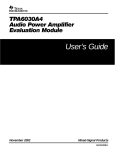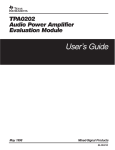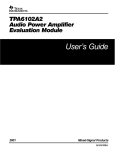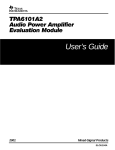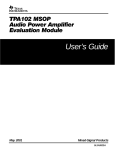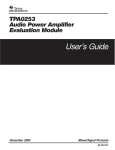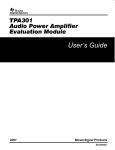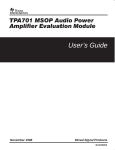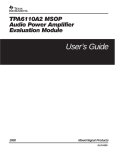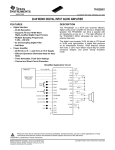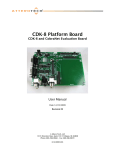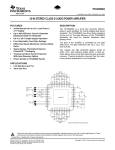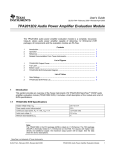Download Texas Instruments TPA3001D1EVM User's Manual
Transcript
User’s Guide December 2002 HPL SLOU156 IMPORTANT NOTICE Texas Instruments Incorporated and its subsidiaries (TI) reserve the right to make corrections, modifications, enhancements, improvements, and other changes to its products and services at any time and to discontinue any product or service without notice. Customers should obtain the latest relevant information before placing orders and should verify that such information is current and complete. All products are sold subject to TI’s terms and conditions of sale supplied at the time of order acknowledgment. TI warrants performance of its hardware products to the specifications applicable at the time of sale in accordance with TI’s standard warranty. Testing and other quality control techniques are used to the extent TI deems necessary to support this warranty. Except where mandated by government requirements, testing of all parameters of each product is not necessarily performed. TI assumes no liability for applications assistance or customer product design. Customers are responsible for their products and applications using TI components. To minimize the risks associated with customer products and applications, customers should provide adequate design and operating safeguards. TI does not warrant or represent that any license, either express or implied, is granted under any TI patent right, copyright, mask work right, or other TI intellectual property right relating to any combination, machine, or process in which TI products or services are used. Information published by TI regarding third–party products or services does not constitute a license from TI to use such products or services or a warranty or endorsement thereof. Use of such information may require a license from a third party under the patents or other intellectual property of the third party, or a license from TI under the patents or other intellectual property of TI. Reproduction of information in TI data books or data sheets is permissible only if reproduction is without alteration and is accompanied by all associated warranties, conditions, limitations, and notices. Reproduction of this information with alteration is an unfair and deceptive business practice. TI is not responsible or liable for such altered documentation. Resale of TI products or services with statements different from or beyond the parameters stated by TI for that product or service voids all express and any implied warranties for the associated TI product or service and is an unfair and deceptive business practice. TI is not responsible or liable for any such statements. Mailing Address: Texas Instruments Post Office Box 655303 Dallas, Texas 75265 Copyright 2002, Texas Instruments Incorporated EVM IMPORTANT NOTICE Texas Instruments (TI) provides the enclosed product(s) under the following conditions: This evaluation kit being sold by TI is intended for use for ENGINEERING DEVELOPMENT OR EVALUATION PURPOSES ONLY and is not considered by TI to be fit for commercial use. As such, the goods being provided may not be complete in terms of required design-, marketing-, and/or manufacturing-related protective considerations, including product safety measures typically found in the end product incorporating the goods. As a prototype, this product does not fall within the scope of the European Union directive on electromagnetic compatibility and therefore may not meet the technical requirements of the directive. Should this evaluation kit not meet the specifications indicated in the EVM User’s Guide, the kit may be returned within 30 days from the date of delivery for a full refund. THE FOREGOING WARRANTY IS THE EXCLUSIVE WARRANTY MADE BY SELLER TO BUYER AND IS IN LIEU OF ALL OTHER WARRANTIES, EXPRESSED, IMPLIED, OR STATUTORY, INCLUDING ANY WARRANTY OF MERCHANTABILITY OR FITNESS FOR ANY PARTICULAR PURPOSE. The user assumes all responsibility and liability for proper and safe handling of the goods. Further, the user indemnifies TI from all claims arising from the handling or use of the goods. Please be aware that the products received may not be regulatory compliant or agency certified (FCC, UL, CE, etc.). Due to the open construction of the product, it is the user’s responsibility to take any and all appropriate precautions with regard to electrostatic discharge. EXCEPT TO THE EXTENT OF THE INDEMNITY SET FORTH ABOVE, NEITHER PARTY SHALL BE LIABLE TO THE OTHER FOR ANY INDIRECT, SPECIAL, INCIDENTAL, OR CONSEQUENTIAL DAMAGES. TI currently deals with a variety of customers for products, and therefore our arrangement with the user is not exclusive. TI assumes no liability for applications assistance, customer product design, software performance, or infringement of patents or services described herein. Please read the EVM User’s Guide and, specifically, the EVM Warnings and Restrictions notice in the EVM User’s Guide prior to handling the product. This notice contains important safety information about temperatures and voltages. For further safety concerns, please contact the TI application engineer. Persons handling the product must have electronics training and observe good laboratory practice standards. No license is granted under any patent right or other intellectual property right of TI covering or relating to any machine, process, or combination in which such TI products or services might be or are used. Mailing Address: Texas Instruments Post Office Box 655303 Dallas, Texas 75265 Copyright 2002, Texas Instruments Incorporated EVM WARNINGS AND RESTRICTIONS It is important to operate this EVM within the supply voltage range of 8 V to 18 V. Exceeding the specified supply voltage range may cause unexpected operation and/or irreversible damage to the EVM. If there are questions concerning the supply voltage range, please contact a TI field representative prior to applying power to the device under test (DUT). Applying loads outside of the specified load impedance may result in unintended operation and/or possible permanent damage to the EVM. Please consult the EVM User’s Guide prior to connecting any load to the EVM output. If there is uncertainty as to the load specification, please contact a TI field representative. During normal operation, some circuit components may have case temperatures greater than 65°C. The EVM is designed to operate properly with certain components above 65°C as long as the input and output ranges are maintained. These components include but are not limited to linear regulators, switching transistors, pass transistors, and current sense resistors. These types of devices can be identified using the EVM schematic located in the EVM User’s Guide. When placing measurement probes near these devices during operation, please be aware that these devices may be very warm to the touch. Mailing Address: Texas Instruments Post Office Box 655303 Dallas, Texas 75265 Copyright 2002, Texas Instruments Incorporated Information About Cautions and Warnings Preface About This Manual This user’s guide describes the characteristics, operation, and use of the TPA3001D1EVM. The user’s guide includes a schematic diagram, bill of materials (BOM), and board layout diagrams. How to Use This Manual This document contains the following chapters: - Chapter 1—Introduction - Chapter 2—Quick Start - Chapter 3—Bill of Materials, Schematic, and PCB Layers Trademarks PowerPAD is a trademark of Texas Instruments. v Information About Cautions and Warnings Information About Cautions and Warnings This book may contain cautions and warnings. This is an example of a caution statement. A caution statement describes a situation that could potentially damage your software or equipment. This is an example of a warning statement. A warning statement describes a situation that could potentially cause harm to you. The information in a caution or a warning is provided for your protection. Please read each caution and warning carefully. vi Contents 1 Introduction . . . . . . . . . . . . . . . . . . . . . . . . . . . . . . . . . . . . . . . . . . . . . . . . . . . . . . . . . . . . . . . . . . . . . 1-1 1.1 Description . . . . . . . . . . . . . . . . . . . . . . . . . . . . . . . . . . . . . . . . . . . . . . . . . . . . . . . . . . . . . . . . 1-2 1.2 TPA3001D1EVM Specifications . . . . . . . . . . . . . . . . . . . . . . . . . . . . . . . . . . . . . . . . . . . . . . 1-3 2 Quick Start . . . . . . . . . . . . . . . . . . . . . . . . . . . . . . . . . . . . . . . . . . . . . . . . . . . . . . . . . . . . . . . . . . . . . . 2.1 Configuration . . . . . . . . . . . . . . . . . . . . . . . . . . . . . . . . . . . . . . . . . . . . . . . . . . . . . . . . . . . . . . 2.2 Precautions . . . . . . . . . . . . . . . . . . . . . . . . . . . . . . . . . . . . . . . . . . . . . . . . . . . . . . . . . . . . . . . . 2.3 Quick Start List for the Platform . . . . . . . . . . . . . . . . . . . . . . . . . . . . . . . . . . . . . . . . . . . . . . . 2.4 Quick Start List for Stand-Alone Operation . . . . . . . . . . . . . . . . . . . . . . . . . . . . . . . . . . . . . 2-1 2-2 2-2 2-4 2-5 3 Bill of Materials, Schematic, and PCB Layers . . . . . . . . . . . . . . . . . . . . . . . . . . . . . . . . . . . . . . 3.1 TPA3001D1EVM Bill of Materials . . . . . . . . . . . . . . . . . . . . . . . . . . . . . . . . . . . . . . . . . . . . . 3.2 TPA3001D1EVM Schematic . . . . . . . . . . . . . . . . . . . . . . . . . . . . . . . . . . . . . . . . . . . . . . . . . 3.3 TPA3001D1EVM PCB Layers . . . . . . . . . . . . . . . . . . . . . . . . . . . . . . . . . . . . . . . . . . . . . . . . 3-1 3-2 3-3 3-4 vii Contents 1–1 1–2 2–1 3–1 3–2 3–3 The TI TPA3001D1 Audio Power Amplifier EVM—Top View . . . . . . . . . . . . . . . . . . . . . . . . The TI TPA3001D1 Audio Power Amplifier EVM—Bottom View . . . . . . . . . . . . . . . . . . . . . Quick Start Platform Map . . . . . . . . . . . . . . . . . . . . . . . . . . . . . . . . . . . . . . . . . . . . . . . . . . . . . . TPA3001D1EVM Schematic Diagram . . . . . . . . . . . . . . . . . . . . . . . . . . . . . . . . . . . . . . . . . . . . TPA3001D1EVM Top Layer . . . . . . . . . . . . . . . . . . . . . . . . . . . . . . . . . . . . . . . . . . . . . . . . . . . . TPA3001D1EVM Bottom Layer . . . . . . . . . . . . . . . . . . . . . . . . . . . . . . . . . . . . . . . . . . . . . . . . . 1-2 1-2 2-3 3-3 3-4 3-4 2–1 2–2 2–3 2–4 2–5 3–1 viii Typical TI Plug-N-Play Platform Jumper and Switch Settings for the TPA3001D1 . . . . . . Typical TPA3001D1EVM Jumper Settings . . . . . . . . . . . . . . . . . . . . . . . . . . . . . . . . . . . . . . . . Platform Jumper and Switch Settings for the TPA3001D1 . . . . . . . . . . . . . . . . . . . . . . . . . . Typical TPA3001D1EVM Jumper Settings . . . . . . . . . . . . . . . . . . . . . . . . . . . . . . . . . . . . . . . . TPA3001D1EVM Gain Settings . . . . . . . . . . . . . . . . . . . . . . . . . . . . . . . . . . . . . . . . . . . . . . . . . TPA3001D1EVM Bill of Materials . . . . . . . . . . . . . . . . . . . . . . . . . . . . . . . . . . . . . . . . . . . . . . . . 2-2 2-2 2-4 2-5 2-7 3-2 Chapter 1 This chapter provides an overview of the Texas Instruments (TI) TPA3001D1EVM class-D audio amplifier evaluation module. It includes a list of EVM features, a brief illustrated description of the module, and a list of EVM specifications. Topic Page 1.1 Description . . . . . . . . . . . . . . . . . . . . . . . . . . . . . . . . . . . . . . . . . . . . . . . . . . . 1-2 1.2 TPA3001D1EVM Specifications . . . . . . . . . . . . . . . . . . . . . . . . . . . . . . . . . 1-3 Introduction 1-1 Description 1.1 Description The TPA3001D1 evaluation module (EVM) is a 20-W class-D mono audio power amplifier complete with a small number of external components mounted on a circuit board measuring approximately 2 1/4 inches by 1 1/2 inches (Figure 1–1 and Figure 1–2). Figure 1–1. The TI TPA3001D1 Audio Power Amplifier EVM—Top View Figure 1–2. The TI TPA3001D1 Audio Power Amplifier EVM—Bottom View Note: Single in-line header pins extend from the underside of the module circuit board to allow the EVM to be plugged into the TI Plug-N-Play audio amplifier evaluation platform, or to be wired directly into existing circuits and equipment when used stand-alone operation. 1-2 TPA3001D1EVM Specifications The platform, which has room for a single TPA3001D1EVM, is a convenient vehicle for demonstrating TI’s audio power amplifier and related evaluation modules. The EVMs simply plug into the platform, which automatically provides power to the modules, interconnects them correctly, and connects them to a versatile array of standard audio input and output jacks and connectors. Easy-to-use configuration controls allow the platform and EVMs to quickly model many possible end-equipment configurations. 1.2 TPA3001D1EVM Specifications Supply voltage range, VCC . . . . . . . . . . . . . . . . . . . . . . . . . . . . . . . . 8 V to 18 V Supply current, Icc . . . . . . . . . . . . . . . . . . . . . . . . . . . . . . . . . . . . . . . . . . 2 A max Continuous output power, RL= 8 Ω, VDD = 18 V, THD+N =10%, PO . 20 W Minimum load impedance, RL . . . . . . . . . . . . . . . . . . . . . . . . . . . . . . . . . . . 4 Ω† † Refer to the TPA3001D1 data sheet for recommendations on the maximum output power when driving a 4-Ω load. Introduction 1-3 1-4 Chapter 2 Follow the steps in this chapter to quickly prepare the TPA3001D1EVM for use. Using the TPA3001D1EVM with the TI plug-n-play audio amplifier evaluation platform is a quick and easy way to connect power, signal and control inputs, and signal outputs to the EVM using standard connectors. However, the audio amplifier evaluation module can be used in stand-alone operation by making connections directly to the module pins, and it can be wired directly into existing circuits or equipment. Topic Page 2.1 Configuration . . . . . . . . . . . . . . . . . . . . . . . . . . . . . . . . . . . . . . . . . . . . . . . . . 2-2 2.2 Precautions . . . . . . . . . . . . . . . . . . . . . . . . . . . . . . . . . . . . . . . . . . . . . . . . . . 2-2 2.3 Quick Start List for the Platform . . . . . . . . . . . . . . . . . . . . . . . . . . . . . . . . 2-4 2.4 Quick Start List for Stand-Alone Operation . . . . . . . . . . . . . . . . . . . . . . 2-5 Quick Start 2-1 Configuration 2.1 Configuration The platform switch and jumper settings shown in Table 2–1 are typical for the TPA3001D1EVM and cause the TPA3001D1 to shut down when a plug is inserted into platform headphone jack J10 (see Note 3 in Table 2–1). Table 2–1. Typical TI Plug-N-Play Platform Jumper and Switch Settings for the TPA3001D1 Notes: Power Type JP1 JP2 JP3 JP4 JP5 JP6 JP7 JP8 S1 S2 (Note 2) S3 VCC (J1) ON OFF OFF ON X Mode X X ON OFF U5 AC/DC (J2) OFF ON OFF ON X Mode X X ON OFF U5 1) ON = Jumper installed, OFF = Jumper NOT Installed, X = Don’t care 2) Set to ON when tone control board SLOP109 is installed in U1, otherwise set to OFF. 3) R3 must be removed from the TPA3001D1EVM to allow the headphone jack to control the shutdown of the TPA3001D1. Table 2–2. Typical TPA3001D1EVM Jumper Settings Note: EVM GAIN0 GAIN1 TPA3001D1 ON ON ON = Jumper installed, OFF = Jumper NOT Installed 2.2 Precautions Power Supply Input Polarity and Maximum Voltage Always ensure the polarity and voltage of the external power connected to VCC power input connector J1, J2, and/or VDD power input connector J6 are correct. Overvoltage or reverse-polarity power applied to these terminals can open onboard soldered-in fuses and cause other damage to the platform, installed evaluation modules, and/or the power source. Inserting or Removing EVM Boards Do not insert or remove EVM boards with power applied. Damage to the EVM board, the platform, or both may result. 2-2 Quick Start List for the Platform 2.3 Quick Start List for the Platform Follow these steps when using the TPA3001D1EVM with the TI plug-n-play audio amplifier evaluation platform (see the platform user’s guide, SLOU011, for additional details). Platform Preparations 1) Ensure all external power sources and platform power switch S1 are set to OFF. 2) Install a TPA3001D1 module in platform socket U2, taking care to align the module pins correctly (EVM power pins engage sockets U2 and U3). 3) Set switch S2 to OFF. 4) Set switch S3 to U5. 5) Set jumper JP6 to select the Mode control input. Table 2–3. Platform Jumper and Switch Settings for the TPA3001D1EVM Notes: Power Type JP1 JP4 JP5 JP6 JP7 JP8 S1 S2 (Note 2) S3 VCC (J1) ON ON X Mode X X ON OFF U5 1) ON = Jumper installed, OFF = Jumper NOT Installed, X = Don’t care 2) Set to ON when tone control board SLOP109 is installed in U1. Power Supply Do not exceed 15 V on the plug-n-play platform, or Zener diode VR1 may fail. If a power supply greater than 15 V is to be used, VR1 must be removed. 6) Ensure power switch S1 is set to OFF. Connect a regulated power supply with an output of 8 V to 15 V to J1, taking care to observe marked polarity. 7) Set jumper JP1 for DC source to be from input J1. 8) Set jumper JP4 for VCC power to EVMs. Inputs and Outputs 9) Ensure that the audio signal source level is set to minimum. 10) Connect the audio source to the right RCA phono jack J3 or the mono miniature phone jack J4. 11) Connect speakers to the right RCA jack J7 or to the stripped wire speaker connectors J8. Quick Start 2-3 Quick Start List for the Platform Figure 2–1. Quick Start Platform Map 1 7 C1+ 8 On Off ICC VR2 JP4 VR1 F2 U6 + Left Out 5 – JP6 U4 Mode Mute Left Out + Stereo Headphone Output HP Out J10 + S3 HP Source GND R3 J9 Lo Hi Spk(U2-U4) C3 C2 JP8 U5 U5 JP7 HP(U5) U2-U4 Polarity TP1 TEXAS INSTRUMENTS 1997 3 Speaker Output 11 + On Conditioning J5 Left In ****CAUTION**** Do not insert or remove EVM boards with power applied Plug-N-Play Audio Amplifier Evaluation Platform SLOP097 Rev. C.1 J6 VDD In/Out U2 U1 10 + Right – Out U3 Off S2 J4 Stereo In Audio Input LED2 VDD Audio Power Amps DC Power In/Out J8 J7 Right Out JP5 IDD LED1 VCC J3 Right In R2 R1 Signal Conditioning 2-4 POWER B1 D1 D2 D3 D4 J2 AC/DC In SUPPLY S1 Pwr Batt 6 JP3 J1 JP2 AC/DC (J2) JP1 VCC(J1) DC SOURCE VCC In + Power Input F1 6 R5 R4 4 Quick Start List for Stand-Alone Operation Evaluation Module Preparations 12) Use jumpers GAIN0 and GAIN1 to set the gain (Table 2–4). Table 2–4. Typical TPA3001D1EVM Jumper Settings GAIN1 Note: GAIN0 GAIN (dB) ON ON 12 ON OFF 18 OFF ON 23.6 OFF OFF 36 ON = Jumper installed, OFF = Jumper REMOVED Power Up 13) Verify correct voltage and input polarity and set the external power supply and platform power switch S1 to ON. Note: Platform LED1 should light indicating the presence of VCC, and the evaluation module(s) installed on the platform should begin operation. 14) Set switch S2 to ON if tone control board SLOP109 is installed in U1. 15) Adjust the signal source level as needed. 2.4 Quick Start List for Stand-Alone Operation Follow these steps to use the TPA3001D1EVM as a stand-alone unit, or when connecting it into existing circuits or equipment. Connections to the TPA3001D1 module header pins can be made via individual sockets, wire-wrapping, or soldering to the pins, either on the top or the bottom of the module circuit board. Power Supply 1) Ensure that all external power sources are set to OFF. 2) Connect an external regulated power supply set from 8 V to 18 V to the module VCC and GND pins taking care to observe marked polarity. It is only necessary to use the ground pins adjacent to the module power pins. Inputs and Outputs 3) Ensure that audio signal source level adjustments are set to minimum. 4) Connect the audio source across the module IN+ and IN– pins, taking care to observe marked polarity. For single-ended input, the negative input pin (IN–) should be connected to the ground of the audio signal source. 5) Connect a speaker to the module OUT+ and OUT– pins, taking care to observe marked polarity. Quick Start 2-5 Quick Start List for Stand-Alone Operation Evaluation Module Preparations 6) Adjust the source signal level as needed. 7) Use jumpers GAIN0 and GAIN1 to set the gain as shown in Table 2–5. Table 2–5. TPA3001D1EVM Gain Settings Note: GAIN1 GAIN0 GAIN (dB) ON ON 12 ON OFF 18 OFF ON 23.6 OFF OFF 36 ON = Jumper installed, OFF = Jumper NOT installed Control Inputs Note: The control signals applied to the EVM shutdown inputs must have sufficient current capability to overcome the 120–kΩ pullup resistor on each input. Holding down S1 places the amplifier in the shutdown state. Releasing S1 returns the amplifier to the active state. Refer to the TPA3001D1 data sheet (SLOS398) for logic threshold voltage ratings. 8) SHUTDOWN: This pin is active low. A low on this pin shuts down the amplifier; a high on this pin places the amplifier in an active state. Leaving this pin floating also allows normal amplifier operation. Power Up 9) Verify correct voltage and input polarity and set the external power supply to ON. The EVM should begin operation. 10) Adjust the signal source level as needed. 2-6 Chapter 3 ! This chapter contains the bill of materials, schematic, and board layout for the TPS3001D1EVM. Topic Page 3.1 TPA3001D1EVM Bill of Materials . . . . . . . . . . . . . . . . . . . . . . . . . . . . . . . 3-2 3.2 TPA3001D1EVM Schematic . . . . . . . . . . . . . . . . . . . . . . . . . . . . . . . . . . . . 3-3 3.3 TPA3001D1EVM PCB Layers . . . . . . . . . . . . . . . . . . . . . . . . . . . . . . . . . . . 3-4 Bill of Materials, Schematic, and PCB Layers 3-1 TPA3001D1EVM Bill of Materials 3.1 TPA3001D1EVM Bill of Materials Table 3–1. TPA3001D1EVM Bill of Materials Reference Description Size Qty MFG. Part Number C1, C2 Capacitor, ceramic, 0.47 µF, 80%/–20%, Y5V, 16 V 0805 2 Panasonic ECJ–2VF1C474Z C3–C6, C10, C11 Capacitor, ceramic, 1 µF, 80%/–20%, Y5V, 25 V C7 Capacitor, electrolytic, 10 µF, 35 V, SMD 0805 7 Panasonic ECJ–2FF1E105Z D 1 Panasonic ECS–T1VD106R C8,C9 Capacitor, ceramic, 0.22 µF, 80%/–20%, Y5V, 16V 0805 2 Panasonic ECJ–2VF1C224Z C12 Capacitor, ceramic, 220 pF, ±10%, X7R, 50 V 0805 1 Panasonic ECU–V1H221KBN C14,C15 Capacitor, ceramic, 1000 pF, ±10%, X7R, 50 V 805 2 Panasonic ECJ–2VB1H102K L1, L2 Ferrite Bead, 0.05 Ω, DCR, 70 Ω at 100 MHz, 3A 1206 2 Fair–Rite 2512067007Y3 R1, R2, R3, R4 Resistor, chip, 120 kΩ, 1/10 W, 5% 0805 4 Panasonic ERJ–6GEYJ124V R5 Resistor, chip, 0 Ω, 1/10W, 5% 805 1 Panasonic ERJ–6GEY0R00V R6, R7 Resistor, chip, 51 Ω, 1/10 W, 5% 0805 2 Panasonic ERJ–6GEYJ510V D1, D2 Schottky diode, Vfm = 0.5 V at 1 A, Vr = 30 V SMA 2 Diodes, Inc. B130–13 J1(GAIN0), J2(GAIN1) Header, 2 position, male 2mm 2 Norcomp 2163–36–01–P2 Shunts 2mm 2 Specialty Electronics 2JM–G S1 (SHUTDOWN) Switch, momentary pushbutton, 12 V, 50 mA 1 Panasonic EVQ–PJS04K PnP pins Headers, 0.1 inch centers, 1/2 inch long 10 Sullins PZC36SABN U1 TPA3001D1PWP 1 TI TPA3001D1PWP 3-2 24-pin TSSOP TPA3001D1EVM Schematic 3.2 TPA3001D1EVM Schematic Figure 3–1. TPA3001D1EVM Schematic Diagram R2 120 kΩ C1 IN– 0.47 µF R1 120 kΩ 1 2 IN+ J1 C2 0.47 µF 3 4 5 J2 SHUTDOWN S1 R3 120 kΩ 7 R5 C10 1 µF 51 Ω VCC C7 10 µF 6 8 9 C8 0.22 µF 10 C5 1 µF 12 11 U1 TPA3001D1 INN VCC INP VREF BYPASS GAIN0 GAIN1 COSC SHUTDOWN ROSC PGND AGND VCLAMP AGND BSN BSP PVCC PVCC OUTN OUTP OUTN OUTP PGND PGND 24 VCC C4 1 µF C3 1 µF 23 22 21 20 C11 1 µF C12 220 pF R4 120 kΩ 19 18 17 R6 16 51 Ω 15 14 VCC C9 0.22 µF 13 C6 1 µF PowerPAD D2 L2 (Ferrite Bead) L1 (Ferrite Bead) C15 1 nF C14 1 nF D1 Bill of Materials, Schematic, and PCB Layers 3-3 TPA3001D1EVM PCB Layers 3.3 TPA3001D1EVM PCB Layers The following illustrations depict the TPA3001D1EVM PCB assembly and layers. These drawings are not to scale. Figure 3–2. TPA3001D1EVM Top Layer Figure 3–3. TPA3001D1EVM Bottom Layer 3-4
























